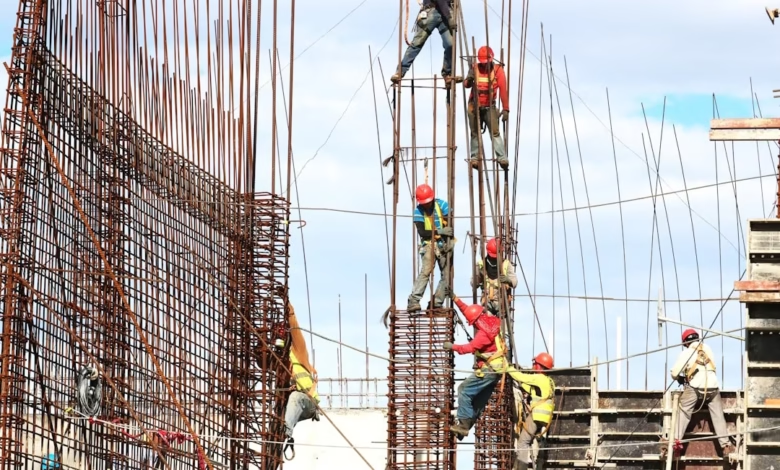Exploring Construction Metals: The Essential Guide to Steel, Aluminum, and Beyond in Modern Building Materials

In the ever-evolving world of construction, the choice of materials significantly influences the efficiency, sustainability, and longevity of structures. Among these materials, construction metals play a pivotal role, encompassing a wide array of both ferrous and non-ferrous metals. From the strength of steel and aluminum to the versatility of copper and zinc, each metal brings unique properties that cater to various building applications. As industries seek to enhance sustainability, innovations in metal recycling and the development of metal alloys have become essential to the future of construction metals. This article delves into the fascinating landscape of construction metals, exploring their roles, the advancements in sustainable metal production, and the intricate world of metal alloys, including precious metals and rare earth metals. Join us as we uncover the latest trends in metallurgy, metal mining, and metal fabrication that are shaping the future of the construction industry.
- 1. Understanding Construction Metals: The Role of Ferrous and Non-Ferrous Metals in Modern Building Materials
- 2. Sustainable Metal Production: Innovations in Metal Recycling and the Future of Construction Metals
- 3. Exploring Metal Alloys in Construction: From Industrial Metals to Precious Metals in Building Applications
1. Understanding Construction Metals: The Role of Ferrous and Non-Ferrous Metals in Modern Building Materials
In modern construction, the choice of materials is pivotal, and understanding the role of metals is essential for architects, builders, and engineers. Construction metals can be broadly categorized into two groups: ferrous and non-ferrous metals. Ferrous metals, primarily composed of iron, include steel and cast iron, and are renowned for their strength and durability. These metals are integral to structural applications, providing the backbone for buildings, bridges, and other infrastructures due to their high tensile strength and resistance to deformation.
On the other hand, non-ferrous metals, such as aluminum, copper, and zinc, play a crucial role in modern building materials as well. Aluminum, known for its lightweight properties and resistance to corrosion, is widely used in facades, roofing, and window frames, making it a favorite in sustainable metal production. Copper, another essential non-ferrous metal, is valued for its excellent conductivity and is commonly used in electrical wiring and plumbing systems. Zinc often serves as a protective coating for steel structures, enhancing their longevity and resistance to metal corrosion.
In recent years, the emphasis on sustainable construction has led to an increased focus on metal recycling. The circular economy encourages the reuse of industrial metals, reducing the need for new metal mining and the environmental impact associated with extracting base metals and precious metals. Recycled metals can be repurposed into new construction materials, making the building industry more eco-friendly. Moreover, advancements in metallurgy have enabled the creation of specialized metal alloys that enhance performance and reduce weight, contributing to more efficient construction practices.
Emerging trends also highlight the growing importance of rare earth metals and battery metals in construction, particularly with the rise of 3D printing metals for custom building solutions. As the demand for energy-efficient and sustainable construction practices increases, the role of metals in building materials will continue to evolve, paving the way for innovative applications in aerospace, automotive, and energy sectors.
Understanding the distinct characteristics of ferrous and non-ferrous metals is essential for making informed decisions about construction materials. Whether it’s gold investing in precious metals or exploring the properties of refractory metals, the diverse range of metals available today underscores their importance in modern architecture and engineering. Their applications extend beyond traditional uses, impacting various industries and shaping the future of construction.
2. Sustainable Metal Production: Innovations in Metal Recycling and the Future of Construction Metals
Sustainable metal production is transforming the construction industry, focusing on innovations in metal recycling and the responsible sourcing of various metals. As the demand for construction metals, such as steel, aluminum, and copper, continues to rise, the need for sustainable practices becomes increasingly critical. Metal recycling plays a vital role in reducing the environmental impact associated with metal mining and production processes. By repurposing ferrous and non-ferrous metals, manufacturers can significantly cut down on energy consumption and greenhouse gas emissions.
Innovations in metallurgy and metal fabrication have led to improved recycling techniques. Advanced processes allow for the efficient recovery of precious metals, base metals, and rare earth metals from scrap materials. This not only supports sustainable metal production but also contributes to the circular economy by minimizing waste. For instance, the integration of 3D printing metals in construction allows for the precise use of materials, reducing excess and enabling the creation of complex structures with less waste.
Furthermore, the rise of battery metals, such as lithium and cobalt, highlights the need for sustainable sourcing practices. As the demand for electric vehicles and renewable energy solutions grows, the construction industry must adapt to these metal trends by investing in sustainable mining practices and recycling methods. Companies are increasingly focusing on the lifecycle of metals, from extraction to end-of-life, ensuring that metal corrosion and degradation are addressed through proper recycling protocols.
Looking ahead, the future of construction metals will likely depend on the continued development of innovative recycling technologies and sustainable practices. With a focus on metal commodities, such as aluminum and zinc, and the increasing importance of energy and aerospace metals, the construction sector can lead the way toward a more sustainable future. By prioritizing sustainable metal production and recycling, the industry can not only meet the growing demand for construction materials but also contribute to a healthier planet.
In conclusion, the integration of sustainable practices in metal production and recycling will be crucial for the future of construction metals. As we continue to explore the potential of various metals, including platinum and palladium, the construction industry must embrace innovation to ensure that it remains both environmentally friendly and economically viable.
3. Exploring Metal Alloys in Construction: From Industrial Metals to Precious Metals in Building Applications
In the construction industry, the role of metal alloys is crucial, as they enhance the performance and durability of building materials. When we talk about industrial metals, we typically refer to metals like steel, aluminum, copper, and zinc, which are essential in various construction applications due to their strength and versatility. Ferrous metals, primarily made from iron, are well-known for their structural integrity, while non-ferrous metals like aluminum and copper offer excellent resistance to corrosion, making them ideal for specific environments.
Metal alloys are engineered to combine the best properties of different base metals. For instance, steel is an alloy of iron and carbon, providing superior strength for structural applications. Aluminum alloys, infused with elements like copper or zinc, are lightweight yet robust, making them popular in modern building designs. Additionally, the integration of rare earth metals and refractory metals in construction can lead to innovations in material performance, particularly in high-temperature and high-stress applications.
Sustainable metal production is gaining traction, with a focus on metal recycling and the use of 3D printing metals to create more efficient designs with less waste. This trend not only conserves resources but also aligns with the growing demand for eco-friendly construction practices. Furthermore, metal mining continues to evolve, aiming to minimize environmental impacts while supplying essential materials for construction.
Investing in metals has become a significant consideration in the construction sector, with gold investing and silver investing remaining popular for their long-term value and stability. The rise of energy metals, such as lithium and platinum, is also noteworthy, as they play a vital role in emerging technologies like battery production for electric vehicles.
Overall, the exploration of metal alloys in construction highlights the importance of metallurgy and the ongoing advancements in metal fabrication. As the industry adapts to new trends and technologies, including the increasing use of automotive and aerospace metals, the future of construction metals promises to be innovative and sustainable, paving the way for resilient infrastructures.
In summary, understanding the diverse applications of industrial and precious metals, along with the implications of metal trends, will be essential for construction professionals looking to leverage these materials effectively in their projects.
In conclusion, the landscape of construction metals is evolving, driven by advancements in metallurgy and a growing emphasis on sustainability. Understanding both ferrous and non-ferrous metals is crucial for modern building practices, as steel and aluminum play a significant role in providing structural integrity and durability. The rise of sustainable metal production, particularly through innovations in metal recycling, showcases a commitment to reducing waste and conserving resources, ensuring that the construction industry remains environmentally responsible.
The exploration of metal alloys further expands the possibilities within building applications, as engineers and architects harness the unique properties of industrial metals and precious metals alike. As we look to the future, trends in metal commodities, such as rare earth metals and battery metals, will become increasingly important, particularly with the integration of technologies like 3D printing metals in construction.
Investing in metals, including gold and silver, not only holds financial potential but also reflects a broader understanding of their practical applications in industries such as aerospace, automotive, and energy. As we continue to innovate in metal fabrication and address challenges like metal corrosion, the versatility and importance of construction metals will undoubtedly grow. Embracing these trends will not only enhance building practices but also contribute to a sustainable future in the construction sector.





